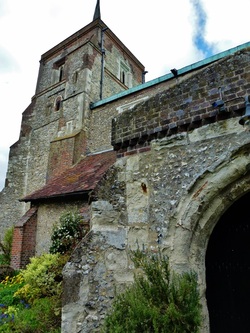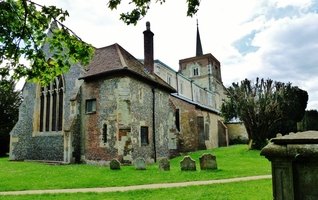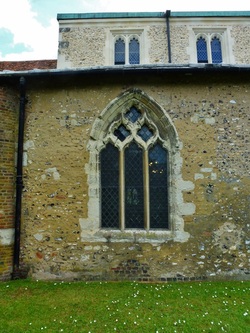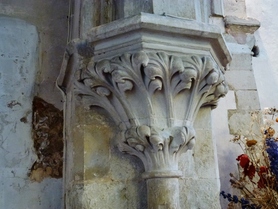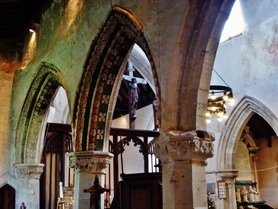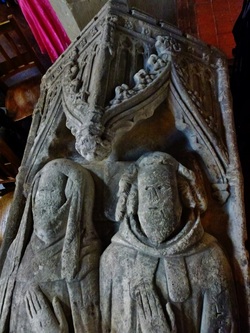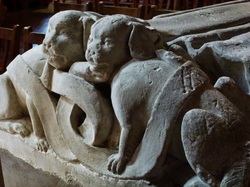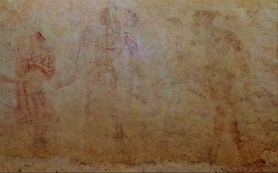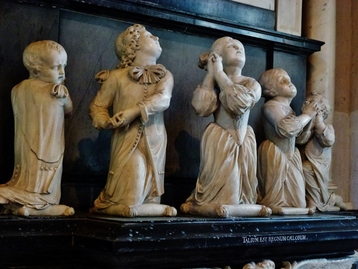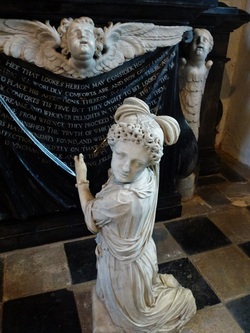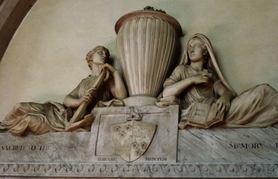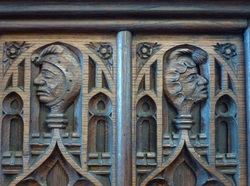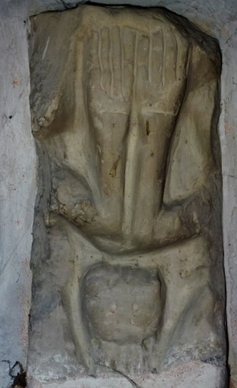St. Leonard, Flamstead.
Doom, death and the devil.
The village spreads around a crossroads on top of a hill within sight of the murmuring M1 below, the patchwork church tower with its spike overlooking the popular pub and low brick almshouses next to the graveyard. The Norman tower and nave gained aisles in the Thirteenth century; the chancel was extended during the next century when several Decorated windows were opened up around the church, and the clerestory and roofs are mostly fifteenth century Perpendicular. There are two low battered porches, and to the north of the chancel is a two storey sacristy built of flint and Roman brick. Despite the iron barred windows, this has a very domestic appearance due to the tall chimney piercing the tiles of the Georgian hipped roof; the fireplace within has been widened, but the flue seems to be an original feature, making this a very snug house for a fourteenth century priest rather than just a chantry chapel. Victorian restorers have laid light hands on the fabric, and its age shows in the melange of materials mixed in the walls, with brick buttresses propping them up on all sides, and everywhere patches of Georgian brick amongst the flint. At the east end of the south aisle fourteenth century flint and stone chequerwork was repaired with rows of Stuart brick and flint, and the ragged top of the tower was finished off in brick around the same time. There’s a picturesque air of make do and mend, leaving the church a patchwork palimpsest clothed in the priceless patina of the past so often tidied away in Victorian times.
Doom, death and the devil.
The village spreads around a crossroads on top of a hill within sight of the murmuring M1 below, the patchwork church tower with its spike overlooking the popular pub and low brick almshouses next to the graveyard. The Norman tower and nave gained aisles in the Thirteenth century; the chancel was extended during the next century when several Decorated windows were opened up around the church, and the clerestory and roofs are mostly fifteenth century Perpendicular. There are two low battered porches, and to the north of the chancel is a two storey sacristy built of flint and Roman brick. Despite the iron barred windows, this has a very domestic appearance due to the tall chimney piercing the tiles of the Georgian hipped roof; the fireplace within has been widened, but the flue seems to be an original feature, making this a very snug house for a fourteenth century priest rather than just a chantry chapel. Victorian restorers have laid light hands on the fabric, and its age shows in the melange of materials mixed in the walls, with brick buttresses propping them up on all sides, and everywhere patches of Georgian brick amongst the flint. At the east end of the south aisle fourteenth century flint and stone chequerwork was repaired with rows of Stuart brick and flint, and the ragged top of the tower was finished off in brick around the same time. There’s a picturesque air of make do and mend, leaving the church a patchwork palimpsest clothed in the priceless patina of the past so often tidied away in Victorian times.
The interior lives up to the hopes raised outside, with the Early English capitals to both arcades of octagonal piers sprouting big fat luscious stiffleaf, worn but deeply undercut. Everything looks fashionably distressed, though a bit of a tidy-up wouldn’t go amiss. There is a late mediaeval rood screen by the same hands as that at Redbourn, and although the dado panels with their jesters’ heads finials seem to be a restoration, they may be as accurate a copy as other details seem to be. Evidence of a late seventeenth century refurbishment is revealed in the pulpit and communion rails of that period, but the church has been rewarded for not having scraped the plaster from the walls by the plethora of paintings discovered in the nave and north aisle. Patterns trail up the soffits of the arches, and the capitals are picked out in green and red. Scenes from the Passion run along the aisle wall in comic book format, drawn in rusty reds in the early fourteenth century. The Last Judgement mural over the chancel arch depicts Christ sitting on a rainbow displaying his wounds, surrounded by angels holding symbols of the Passion. The heavenly city appears to the left, and a horned blue demon on the south above a hellmouth’s giant eye[19]. In the nave above the arches there are remains of large thirteenth century figures of barefoot apostles: superimposed on the north is a huge faint fifteenth century St. Christopher, the mere sight of which guaranteed that death if it came would be within a state of grace. On the south side stand three skeletons, giving to three fashionable huntsmen out hawking a surely superfluous warning of the imminence of immortality; a memento mori mural based on the popular tale of the Three Living and Three Dead.
There is a wide range of monuments scattered around the church, though the brasses are buried under unfortunate chancel carpet. Under the north arcade is a late fourteenth century tomb chest on which a sergeant at law, Thomas Frisby and his wife lie holding hands, an ogee canopy over their battered heads and puppies playing at their feet within a ribbon like scroll. This tomb has some small scale similarities with tombs at Little Munden and Bennington. Opposite at the east end of the south aisle is an expensive memorial by Edward Stanton of around 1690, a tall black and white tomb on which five deceased Saunders children kneel in marble prayer, with the surviving shrouded sister in front on the floor. In the chancel Sir Bartholomew Fouke kneels in armour at a prayer desk in a classical Jacobean niche on the south wall. Opposite him is a big dull neo-classical memorial to Sir Edward Sedbright, carved by John Flaxman in 1782 within an existing shallow gothic arch, the heraldic arms being a Coade stone cast. Hope with an anchor and Faith with a bible lean back against a fluted urn over a half empty expanse of marble, devoid of direct descendants, fecundity having failed. One of the Sedbrights buried below was murdered, the other died childless, leaving only distant relatives scattered around the globe.
The final memorials are heartfelt but humble, no marmoreal monsters decreed by the dead. These are the epitaphs to neighbours and friends, graffiti simply cut into an arcade pier. Many tombs are an egotistical attempt at eternal fame, erected either during the lifetime of the subject or because of a requirement written into a will. These three Elizabethan epitaphs are practical and private, a last act of friendship for the dead, just rhyming couplets, a date and a name. Interestingly, they seem to show that by this period people were buried under the pews where they usually sat, rather a nice idea.
Two carved stones can be seen in the south aisle; a fifteenth century angel roof corbel holding a shield lies loose on a windowsill, and a fragmentary carving supports a small shelf. This latter looks Norman, and shows two disembodied arms and a skull or lion’s head; it may be parts of two Atlas or orans figures from a font, now fixed upside down.
This interesting church is now open to view during daylight hours throughout the year, a happy change from the years when it was necessary to ring the vicar to arrange to get in. Much funding for conservation and building repairs comes from public and charitable funds and if the public can see what it is paying for this is more likely to continue in the future. If the church must for security reasons be locked[20], then a key should be available nearby; no one learns to love a locked building, and churches need every friend they can get.
Two carved stones can be seen in the south aisle; a fifteenth century angel roof corbel holding a shield lies loose on a windowsill, and a fragmentary carving supports a small shelf. This latter looks Norman, and shows two disembodied arms and a skull or lion’s head; it may be parts of two Atlas or orans figures from a font, now fixed upside down.
This interesting church is now open to view during daylight hours throughout the year, a happy change from the years when it was necessary to ring the vicar to arrange to get in. Much funding for conservation and building repairs comes from public and charitable funds and if the public can see what it is paying for this is more likely to continue in the future. If the church must for security reasons be locked[20], then a key should be available nearby; no one learns to love a locked building, and churches need every friend they can get.
[19] The entrance to Hell is often shown as the maw of a giant beast in mediaeval murals, with demons casting sinners inside.
[20] In the thirteenth century, men who had looted Redbourn’s church moved on to rob Flamstead, where a spirit caused one of them to go mad; making him shake so much that a stolen cross fell to the ground in front of the priest, leading the other thieves to confess to their crimes. Might not work today, of course.
[20] In the thirteenth century, men who had looted Redbourn’s church moved on to rob Flamstead, where a spirit caused one of them to go mad; making him shake so much that a stolen cross fell to the ground in front of the priest, leading the other thieves to confess to their crimes. Might not work today, of course.
All rights reserved for this entire site. Copyright reserved to stiffleaf for all text and images, which may not be reproduced without my permission.
